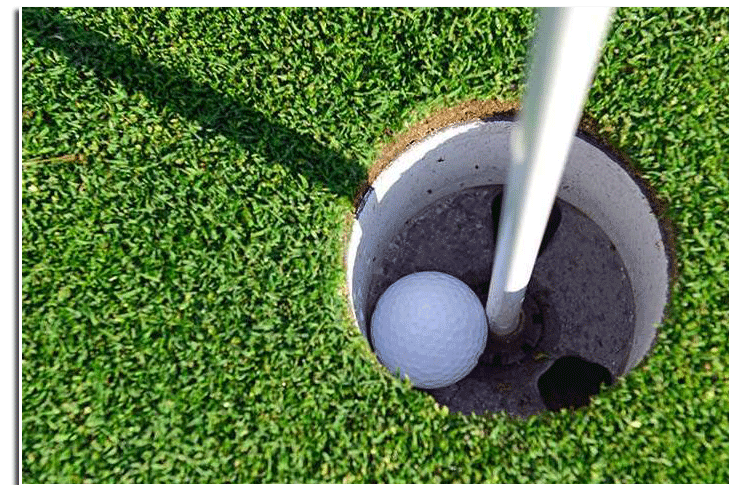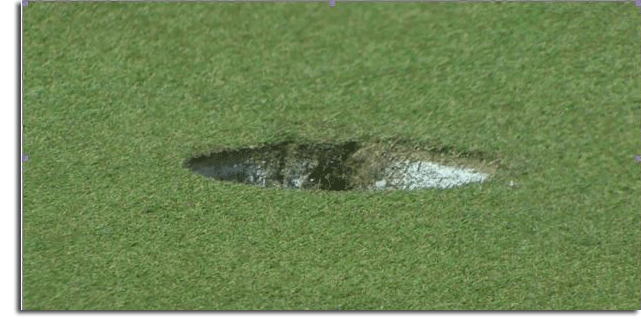August - 2019
The Flagstick Remains Are You Careful Not To Damage The Edge Of The Hole When Removing Your Golf Ball From The Hole While In The Hole?
Feedback on the new Rules of Golf have been generally positive, and feedback on the new Rule allowing players to leave the flagstick in the hole have been overwhelmingly positive. We have been told that most of you are leaving the flagstick in the hole while putting and pace of play has improved. The main complaint being received regarding players leaving the flagstick in the hole is that players, either reaching their hand into the hole to remove a ball or, and this appears to be the main cause of damage, using a suction cup on the end of their grip into the hole, are damaging the hole. The Villages at the Golf Hall of Fame near St. Augustine, FL considered this such a big issue at their 43 courses that they published an article in their community's newspaper asking golfers to remove the flagstick before removing their ball from hole.
Have you seen damage to the holes that looks similar to the picture below? I have, and way too often since the rule permitting keeping the flagstick in the hole. IF USING A SUCTION CUP AT THE END OF THE CLUB, AND IF YOU HAVE ONE OF THOSE BIG GRIPS, PLEASE DON'T GRAB YOUR BALL WITH THAT SUCTION CUP WITHOUT FIRST REMOVING THE FLAGSTICK. IF YOU HAVE A NORMAL SIZED GRIP, THEN THE CLUB MUST BE PLACED VERTICALLY, AND PARALLEL TO THE FLAGSTICK TO RETRIEVE YOUR BALL AND NOT AT AN ANGLE. THEN PLEASE BE MINDFUL OF YOUR FOOTSTEPS AROUND THE HOLE WHICH COULD CAUSE DEPRESSIONS AND AFFECT THE ROLL OF THE GOLF BALL FOR THE NEXT GROUP OF PLAYERS OR THE REMAINING PLAYERS IN YOUR PAIRING.


Rule 13.1c Improvements Allowed on Putting Green - allows players to repair damage on the putting green without penalty. Players may use their hand, foot, repair tool, club, or similar item of normal equipment to make these repairs (you cannot use a rolling pin from your kitchen). The improvements need to be made without unreasonable delay. Examples of damage that can be repaired are ball marks, shoe damage, scrapes or indentation caused by equipment or a flagstick, old hole plugs, turf plugs, sod seams, scrapes and indentations from maintenance tools or vehicles, animal tracks or hoof indentations, and embedded objects like stones or acorns.
Examples of damage that cannot be repaired are aeration holes, grooves from vertical mowing (verticutting), damage from irrigation, damage from rain, damage form nature forces, natural surface imperfections (weeds, bare areas, diseased areas, uneven growth, etc.), and natural wear of the hole.
The common question we receive is, can players repair damage to the hole? Interpretation 13.1c(2)/2 - Damaged Hole is Part of Damage on the Putting Green clarifies that damage to a hole may be repaired by the player; however, if the damage is so severe that it is not possible to repair (such as the hole cannot be made round again) that the player should request the Committee to repair it. We don't have a committee during our tournament rounds that can make the repair, but if you have a cell phone, call the pro shop and ask them to have one of the greenskeepers come out to the hole to make the repair. In a tournament, the hole location should be the same for all the players, but if the damage is so severe that the hole would need to be removed, the hole should be relocated somewhere near the existing hole so as to keep the tournament conditions the same for all players.
We are not suggesting a mandate that golfers remove the flagstick before removing their ball from the hole, rather we encourage all golfers to use great care when doing so. If your hand is too large, or you cannot physically remove a ball without scraping the edge of the hole, please consider removing the flagstick before removing your ball. Also, it is okay to leave your ball in the hole and let other players hole out and let someone else remove your ball.
The spirit of the game of golf includes care of the course and consideration for others, so please be careful to not damage the hole.
![]()